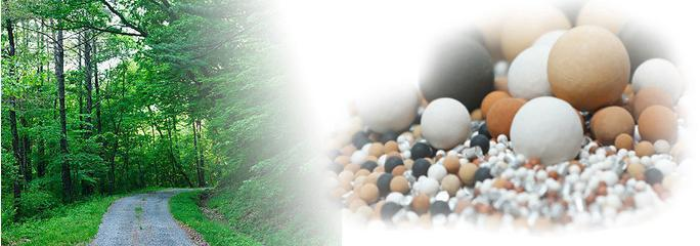Silver ion-substitution ball
The difference between silver ions and nano silver particles is that the sizes are different and the sterilizing effects also are different.

Silver ion substitution ceramic ball (Features)
The difference between silver ions and nano silver particles is that the sizes are different and the sterilizing effects also are different. As the result of comparing the characteristics of microorganism inactivation of nano silver particles with those of microorganism inactivation on silver ions by using a scanning electron microscope and a transmission electron microscope.
- Based on the equal concentration of silver (Ag), silver ions have about 20 times higher antifungal and sterilizing effects compared to those of nano silver particles.
- The higher silver (Ag) concentration and temperature become, the more the antifungal and sterilizing efficiency improves, which coincides with the same capacity even in the results of experiments of silver nano particles and silver ions.
- While the antifungal and sterilizing capacity of nano silver particles improves at higher pH, silver ions show a high antifungal and sterilizing efficiency regardless of the change of pH.
- Silver ions are absorbed in the blood of all internal Organs and finally discharged from the body, but there is a high possibility that nano silver can be deposited in internal organs because it is a particle.
The sterilization mechanism of the silver ion substitution ceramic ball can be divided into two types : one is that activated oxygen generated from the ball annihilates microbes and the other is that silver ions eluted from the ceramic ball inactivate microbes by damaging RNA or DNA inside the cytoplasm as the ions are absorbed into microbes. However, in case of nano silver, it damages greatly only the cells of microbes. Accordingly, we can know that the sterilizing effect of silver ions is greater than that of silver mano.
Antifungal and sterilization testing of the silver ion-exchange composite substitute agent
1. Strain used : Escherichia Coli ATCC 25922
| Test item | Antifungal ball WP103 | Test method | |||
|---|---|---|---|---|---|
| BLACK | Number of bacteria (CJU/100P) | Bacteria reduction rate(%) | |||
| Test item by Escherichia coil | At the initial stage | 3.5 x 106 | 3.5 x 106 | - | Presented by the client |
| After 10 minutes | 1.0 x 103 | 99.97 | |||
| After 30 minutes | ∠10 | 99.99 | |||
| After 60 minutes | ∠10 | 99.99 | |||
2. Strain used : MRSA (Staphylococcus aureus Subsp aureus ATCC 33951)
| Test item | Antifungal ball WP103 | Test method | |||
|---|---|---|---|---|---|
| BLACK | Number of bacteria (CJU/100P) | Bacteria reduction rate(%) | |||
| Antifungal testing by MRSA | At the initial stage | 1.8 x 106 | 1.8 x 106 | - | Presented by the client |
| After 10 minutes | 9.7 x 104 | 94.55 | |||
| After 30 minutes | 5.1 x 104 | 97.16 | |||
| After 60 minutes | 4.0 x 104 | 99.77 | |||
3. Strain used : Pseudomonas aeruginosa ATCC 15442
| Test item | Antifungal ball WP103 | Test method | |||
|---|---|---|---|---|---|
| BLACK | Number of bacteria (CJU/100P) | Bacteria reduction rate(%) | |||
| Antifungal testing by Pseudomonas aeruginosa | At the initial stage | 2.38 x 106 | 2.3 x 106 | - | Presented by the client |
| After 10 minutes | 1.0 x 104 | 95.65 | |||
| After 30 minutes | 1.31 x 105 | 99.43 | |||
| After 60 minutes | ∠10 | 99.99 | |||
4. Mold strains(mixed strains)
Aspergillus niger ATCC 9642 / Gliocladium virens ATCC 9645
Penicillium pinophilum ATCC 11797 / Aureobasidium pullalans ATCC 15233
Chaetomium globosum ATCC 6205
| Test item | Anti-mold testing | |||
|---|---|---|---|---|
| Cultivation test period | ||||
| After 1 week | After 2 weeks | After 3 weeks | After 4 weeks | |
| Test results | O | O | O | O |
| Test method | ASTMG - 21 (2002) | |||
# All of the above are the results of the tests (Escherichia coli, yellow taphylococcus, Pseudomonas aeruginosa, mold strains) made on June 18, 2009 at Korea Institute of Construction Materials.
